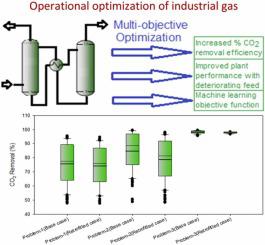Process Safety and Environmental Protection ( IF 6.9 ) Pub Date : 2023-05-09 , DOI: 10.1016/j.psep.2023.05.011 Debasish Tikadar , Ashish M. Gujarathi , Chandan Guria

|
Natural gas processing is currently facing economic and environmental challenges due to abrupt changes in oil prices and the development of an alternate source of energy. Therefore it is essential to optimize the processing unit to make it profitable and environmentally friendly. Sustainable optimization of an industrial natural gas treatment plant is carried out using the NSGA-II algorithm for the methyl diethanol amine (MDEA) process to optimize CO2 removal along with payback period and damage index. This multi-objective optimization study includes seven decision variables such as temperature and pressure of feed gas, feed flow rate, temperature and pressure of regenerator feed, lean amine temperature, and MDEA concentration. Three separate two-objective optimization study problems are developed and applied for retrofitted case and base case studies. Two different ProMax models are developed and validated the model by using actual plant data. All the retrofitted cases and base cases are solved and the Pareto optimal fronts are obtained. Trade-offs between different objectives are illustrated for all the problems. The lean vapor compression process can facilitate maximum H2S removal of 99.75% and maximum CO2 removal of 98.52% simultaneously by maintaining a DI value of 476. TOPSIS method is used to rank and find the best optimal solution. Optimization study for uncertain CO2 concentration (4%mole) in the feed gas is also analyzed and compared with normal feed conditions. The machine learning approach is used to obtain the predictions of selected objective functions for all the problem cases using the decision tree method.
中文翻译:

对工业气体脱硫过程进行基于改造的多标准分析:对 CO2 排放的进一步了解
由于石油价格的突然变化和替代能源的开发,天然气加工目前面临经济和环境挑战。因此,必须优化处理单元以使其有利可图且对环境友好。使用 NSGA-II 算法对甲基二乙醇胺 (MDEA) 工艺进行工业天然气处理厂的可持续优化,以优化 CO 2移除以及投资回收期和损坏指数。该多目标优化研究包括七个决策变量,例如进料气的温度和压力、进料流量、再生器进料的温度和压力、贫胺温度和MDEA浓度。开发了三个独立的双目标优化研究问题,并将其应用于改造案例和基础案例研究。开发了两种不同的 ProMax 模型,并使用实际工厂数据验证了模型。解决了所有改造案例和基本案例,并获得了帕累托最优前沿。针对所有问题说明了不同目标之间的权衡。贫蒸汽压缩工艺可促进最大程度地去除 99.75% 的H 2 S 和最大程度地去除 CO 2通过保持 476 的 DI 值同时去除 98.52%。TOPSIS 方法用于排序并找到最佳最优解。还分析了进料气中不确定 CO 2浓度(4% 摩尔)的优化研究,并与正常进料条件进行了比较。机器学习方法用于使用决策树方法获得所有问题案例的选定目标函数的预测。













































 京公网安备 11010802027423号
京公网安备 11010802027423号